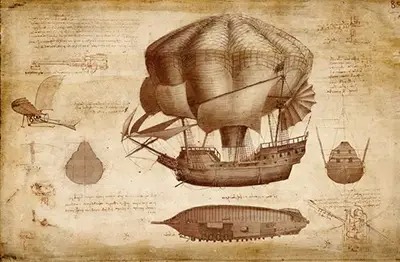In front of us there are several different elements to study. Besides each one are also a number of notes which would have helped to explain the artists ideas, particularly when working with inventions that might have been harder to grasp at the time. We find a single-man flight machine to the left hand side, a design that appears in a number of other drawings by this artist. He was perhaps expanding on that existing idea and finetuning how he wanted the thing to look and function. The main part of the paper is given over to the sketch of a ship, with several different angles covered on the same page. You may notice a balloon type construction coming from the centre of the ship which suggests that this was a design for an early air balloon. Essentially, the artist had planned for a ship to be able to fly, which as crazy as it would have sounded at the time, was pretty much what later occurred some centuries afterwards.
Many of Da Vinci's inventions would be realised, but not during his own time. It was only later when some of these drawings were discovered that we realised how far ahead of time his thinking was. He was a highly accomplished draughtsman and also exceptionally hard working and so there was always plenty of time to expand on interesting ideas that seemed to occur to him fairly often. His knowledge of different mediums would also help each other, such as his engineering which benefitted his inventive ideas and he became knowledgeable on how these different ideas might actually work in practice.
In terms of raw technical ability, we can consider this artist to be amongst the most accomplished draughtsman in history. He practiced endlessly and also took on a good variety of topics within this medium. He continually worked on his anatomical skills, which is a famously hard discipline to master. He then used sketching to plan architecture and inventions, with a whole host of different projects coming his way as his own reputation begun to reach extraordinary levels, even during his own lifetime. Such drawings are fragile and therefore hard to see in person, but most have been documented within various publications, some of which present them as large images from which you can appreciate some of the mastery of Da Vinci.
